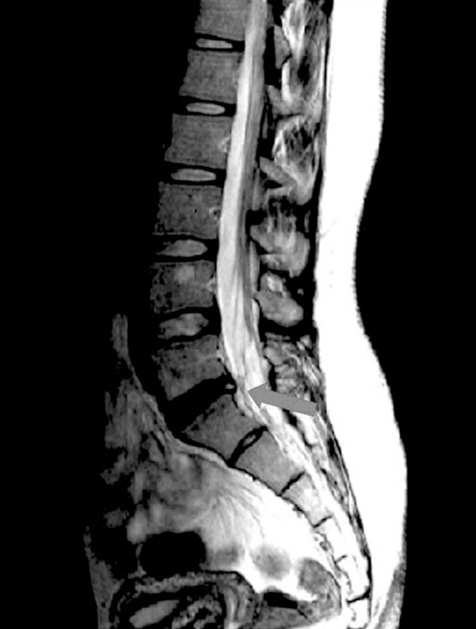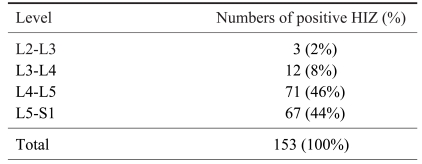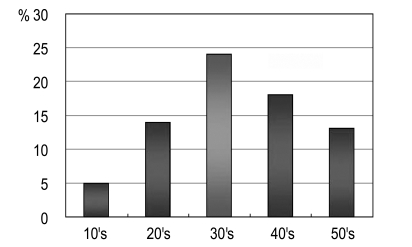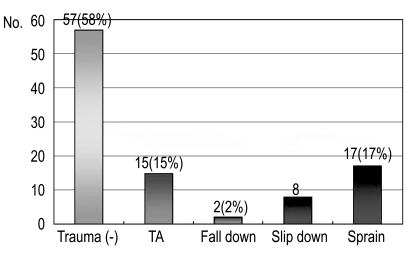Abstract
Study Design
This is a retrospective study.
Purpose
We wanted to investigate the clinical relevance of the lumbar high intensity zone (HIZ) on magnetic resonance imaging (MRI) and the relationship of trauma history to internal disc disruption (IDD).
Overview of Literature
HIZs on lumbar spine (L-spine) MRI have been suggested as a reliable marker of IDD by some authors. The prevalence and type of spinal trauma in IDD have not yet been carefully analyzed.
Methods
L-spine MRIs of 737 patients with low back pain with or without associated leg pain were reviewed for the presence of HIZs. HIZs on T2-weighted MR images were determined according to the Aprill and Bogduk criteria. A review of medical records and a telephone interview were performed for further analyses of pain.
Results
HIZs were found in 117 patients and 153 discs among a total of 737 patients who met the inclusion criteria. Both a medical record review and a telephone interview were possible with 99 patients. Among these, 42 patients had had an episode of trauma. Seventeen of these had a relatively high-energy injury such as a traffic accident or a fall. Regarding back pain, 27 patients complained of typical discogenic back pain. Only 11 patients had both a trauma history and typical discogenic pain and 41 patients (42%) had neither a trauma history nor typical natural pain.
Conclusions
Given the low incidence of discogenic pain, a HIZ on an L-spine MRI appears less meaningful than often assumed as a specific marker of IDD. Trauma, such as a traffic accident, seems unlikely to be the main cause of IDD.
Keywords: High-intensity zone, Trauma history, Discogenic pain, Internal disc disruption
Introduction
Internal disc disruption (IDD) was first described by Crock1,2 in the 1970s. IDD was considered to be a disease associated with chronic low back pain refractory to conservative management and caused by abnormal metabolism of internal structures of the disc. However, there has been debate over this new disease3-6. Though trauma has been suggested as one of the causes of IDD, there have only been a few studies conducted to verify the relationship between trauma and IDD. The prevalence and type of spinal trauma relative to IDD have not yet been analyzed carefully2,7. The high-intensity zone (HIZ) is the bright white signal in the posterior annulus on T2 weighted MR images and is thought to be a radial tear in the posterior annulus of the disc. Some studies have reported that the HIZ was a reliable marker of IDD, while others disagreed8-13. However, many physicians make a hasty diagnosis of IDD with only a patient's trauma history and HIZ present on MRI instead of performing invasive discography.
We wanted to investigate the clinical relevance of a lumbar HIZ on an MRI and the relationship of trauma history to IDD by evaluating the prevalence and type of spinal trauma and patterns of low back pain of patients in whom lumbar MRI HIZs were found.
Materials and Methods
We undertook retrospective analysis of 2,173 consecutive patients who had undergone MR imaging of the lumbar spine for evaluation of low back with or without associated leg pain from January 2002 to December 2003. Patients who were under 10 years old or over 60 years old and who were diagnosed with infectious spondylitis, spinal deformities, spinal fractures, tumors, spinal stenosis, spondylolithesis, herniated lumbar intervertebral discs and who had previous surgical procedures were all excluded from further analysis. L-spine MR images of a total of 737 patients were reviewed for the presence of HIZs. The criteria of HIZs as described by Aprill and Bogduk8 was used. HIZs were defined as a bright white signal located in the substance of the posterior annulus fibrosis, clearly dissociated from the signal of the nucleus pulposus in that it was surrounded by the low-intensity (black) signal of the annulus fibrosus and was appreciably brighter than that of the nucleus pulposus on T2-weighted sagittal MR images (Fig. 1). HIZs were found in 117 patients and 153 intervertebral discs. Further analysis was performed on 99 patients with whom both a medical record review and a supplementary telephone interview were possible.
Fig. 1.
Mid-sagittal T2-weighted MR image (TR 2200, TE 70) shows a uni-segmental degenerated disc at L5-S1 with a high-intensity zone in the posterior annulus (arrow).
The prevalence and type of trauma was investigated through medical record reviews and telephone interviews. Location, severity, presence of associated leg pain, total pain duration, as well as aggravating and relieving factors were evaluated for the nature of low back pain.
The type of trauma was categorized into two types of injury: a high-energy injury and a low-energy injury. Traffic accidents, and falls were classified as high-energy injuries. Slips and sprains in the course of daily living were classified as low-energy injuries. Pain refractory to over 6 months of conservative treatment, aggravated by sitting for a long time, standing from a sitting position, lifting and forward bending of low back and relieved by lying supine was defined as typical discogenic pain. The pain aggravated by walking, hyperextending of the low back or changing position frequently and not relieved by lying down was defined as nonspecific low back pain1,3,6,14.
Statistical analyses were carried out with SPSS 12.0 (SPSS Inc., Chicago, IL, USA). The confidence interval was set at 95%, corresponding with a significance level of p<0.05.
Results
Of the 737 patients who underwent L-spine MRIs, 13% (51/391 patients) of the men and 19% (66/346 patients) of the women exhibited HIZs on their MRIs. HIZs occurred largely at L4-5 (46%, 71 patients) and L5-S1 (44%, 67 patients) (Table 1). The prevalence of HIZs was significantly highest in patients 31~40 years old patients (24%, 28/117, p<0.05) (Fig. 2).
Table 1.
Levels of positive HIZs on L-spine MR images in 117 patients, 153 discs
HIZ: high-intensity zone.
Fig. 2.
Age prevalence of positive high-intensity zone on MRI in 737 patients was highest at 4th decades (p<0.05).
Of the 99 patients available for medical record reviews and telephone interviews, 55 patients (56%) had experienced chronic low back pain for more than 6 months that was refractory to conservative management. Most patients had mild to moderate back pain that was relieved by rest. Only 19 patients complained of severe debilitating low back pain that disturbed their daily lives. Twenty-seven patients (31%) had typical discogenic pain, and the rest of the patients had the nonspecific low back pain.
Forty-two patients had trauma history related to their back pain, and 57 patients denied having trauma history. Of the 42 patients with trauma history, 17 patients had experienced a high-energy injury such as a traffic accident or fall, and others had minor trauma such as a slip or a strain (Fig. 3).
Fig. 3.
Most patients (58%) has no trauma history related to their back pain and only 17 patients has history of high energy injury.
Only 11 patients had both typical discogenic pain and trauma history related to their back pain and most patients had nonspecific low back pain or did not have trauma history despite the HIZ found on their MRIs (Table 2). Trauma history was not related to typical discogenic pain (p=0.51).
Table 2.
Relationship between trauma history and pain nature in HIZ positive patient. Trauma history was not related to typical discogenic pain (p=0.51)
HIZ: high-intensity zone.
Thirteen patients had a medicolegal indemnity such as worker's compensation. Ten patients (77%) insisted the trauma was related to their back pain, and 8 (80%) patients had a high-energy injury. However, only 3 patients complained of typical discogenic low back pain.
Discussion
IDD was first described by Crock1 in the 1970s, but there are still strong controversies about its pathology, history, diagnostic criteria, treatment, and even its existence. Blumenthal et al.15 suggested 4 diagnostic criteria: 1) trauma history, 2) no neurological abnormality and normal simple radiograph findings, 3) existence of axial back pain that does not subside by conservative treatment over 6 months, and 4) positive findings in discography. They insisted that these four criteria must be satisfied to confirm IDD.
Discography has been accepted as the confirmative test in diagnosing IDD, but discography is too invasive, and its evaluation depends on the patient's subjective pain response. These disadvantages have limited physicians from routinely performing the procedure. The presence of a HIZ om MR Imaging has been suggested as a reliable alternative to discography. Recently, there has been a tendency that if a patient with history of trauma such as a traffic accident has clinically significant back pain, diagnosis is made tactlessly as IDD only by HIZs on L-spine MR images without discography. However, this can result in overdiagnosis and unnecessary treatment, including surgery.
Crock suggested trauma as the major cause of IDD. He presumed that the primary defects of IDD were in the fields of chemical pathology and in the mechanisms of disc nutirition1,2. If the internal structure of the disc is disrupted by trauma, the disrupted materials are absorbed through the vascular channel to the spinal canal and systemic circulation. This stimulates the nerve, and the autoimmune response creates pain and disturbs the disc nutrition. However, this suggestion is only a theoretical hypothesis. There is no experimental study confirming that degeneration of the disc by trauma can lead to IDD. Also, few have evaluated the incidence and type of trauma in IDD and investigated the relationship between trauma and IDD. In this study, the authors found that 58% of patients with HIZs on their L-spine MR images had no history of trauma related to the development of back pain, and only 17% of patients with a trauma history had experienced high-energy injuries that could cause disruption of the disc. Thus, the authors believe, as proposed by Kirkaldy-Willis et al.14, that the degeneration of disc material and radial tear of posterior annulus, rather than being caused by trauma, is the result of spinal instability and serial disc degenerative changes such as a decrease of water content and glycosaminoglycan and imbalance of tissue matrix metalloproteinase levels. The high prevalence of HIZs in patients in their 40s and 50s in which the degeneration process could start and the relatively low prevalence in patients over 50 years old provides further evidence.
HIZs on MRI images were first described by April et al in 1992, but there are still many controversies about its diagnostic value8,13. Schellhas et al.12, examining symptomatic subjects with at least one HIZ positive disc on MRI, found that 87% of the HIZ positive discs were concordantly painful at discography and discography did not elicit concordant pain in 65 of 67 HIZ negative discs. They concluded that the presence of a HIZ was a sign of a symptomatic internal disc disruption. In contrast, Ricketson et al.11 reported that although HIZs were not found in normal discs, there was no significant correlation between the presence of HIZs and concordant pain with discography. Carragee et al.10 also noted that a HIZ on a MRI was found in 24% of asymptomatic subjects, and in cases with positive HIZs, the rates of positive results with discography were not different between the symptomatic and asymptomatic groups. They concluded that HIZs could not be considered as a specific finding of IDD. In the present study, only 31% of the patients with HIZs on their MRIs described typical discogenic pain. We conclude that HIZs cannot be considered as a specific finding of IDD.
This study is a retrospective study without discography and this can be its own limitation. We made very careful decisions about whether the nature of a patient's low back pain was discogenic axial back pain or not through delicate questions in telephone interviews and medical records reviews, but there were differences in the description of severity of subjective pain in each person. Therefore, without confirmative discography, the nature of low back pain can be still insufficient to diagnose a patient with IDD. Nevertheless, in most patients, the nature of low back pain was not axial but nonspecific which was worsened by hyperextension of the back or walking, and there was no episode of high-energy injury that could result in degeneration of the disc. Only 11% of the patients had both trauma history and typical discogenic pain. So, we concluded that diagnosing IDD by trauma history, such as a traffic accident, and the presence of a HIZ on MRI imaging may lead to false diagnosis and unnecessary surgical treatment.
Conclusions
The presence of HIZs on MR images showed very weak correlation to trauma, because most patients had no trauma history or low-energy injuries. Trauma, such as a traffic accidents and falls, seem unlikely to be the main cause of IDD.
Given the low incidence of a typical discogenic pain, HIZs on an L-spine MRI appears less meaningful than often assumed as a specific marker of IDD. Clinical consideration of these findings and discography should be necessary to diagnose IDD.
References
- 1.Crock HV. A reappraisal of intervertebral disc lesions. Med J Aust. 1970;1:983–989. [PubMed] [Google Scholar]
- 2.Crock HV. Internal disc disruption. A challenge to disc prolapse fifty years on. Spine. 1986;11:650–653. [PubMed] [Google Scholar]
- 3.Lee KS, Doh JW, Bae YG, Yun IG. Diagnostic criteria for the clinical syndrome of internal disc disruption: are they reliable? Br J Neurosurg. 2003;17:19–23. [PubMed] [Google Scholar]
- 4.Lee CK, Vessa P, Lee JK. Chronic disabling low back pain syndrome caused by internal disc derangements. The results of disc excision and posterior lumbar interbody fusion. Spine. 1995;20:356–361. doi: 10.1097/00007632-199502000-00018. [DOI] [PubMed] [Google Scholar]
- 5.Luoma K, Riihimaki H, Luukkonen R, Raininko R, Viikari-Juntura E, Lamminen A. Low back pain in relation to lumbar disc degeneration. Spine. 2000;25:487–492. doi: 10.1097/00007632-200002150-00016. [DOI] [PubMed] [Google Scholar]
- 6.Schwarzer AC, Aprill CN, Derby R, Fortin J, Kine G, Bogduk N. The prevalence and clinical features of internal disc disruption in patients with chronic low back pain. Spine. 1995;20:1878–1883. doi: 10.1097/00007632-199509000-00007. [DOI] [PubMed] [Google Scholar]
- 7.Cooke PM, Lutz GE. Internal disc disruption and axial back pain in the athlete. Phys Med Rehabil Clin N Am. 2000;11:837–865. [PubMed] [Google Scholar]
- 8.Aprill C, Bogduk N. High-intensity zone: a diagnostic sign of painful lumbar disc on magnetic resonance imaging. Br J Radiol. 1992;65:361–369. doi: 10.1259/0007-1285-65-773-361. [DOI] [PubMed] [Google Scholar]
- 9.Boden SD, Davis DO, Dina TS, Patronas NJ, Wiesel SW. Abnormal magnetic-resonance scans of the lumbar spine in asymptomatic subjects. A prospective investigation. J Bone Joint Surg Am. 1990;72-A:403–408. [PubMed] [Google Scholar]
- 10.Carragee EJ, Paragioudakis SJ, Khurana S. 2000 Volvo Award winner in clinical studies: lumbar high-intensity zone and discography in subjects without low back problems. Spine. 2000;25:2987–2992. doi: 10.1097/00007632-200012010-00005. [DOI] [PubMed] [Google Scholar]
- 11.Ricketson R, Simmons JW, Hauser BO. The prolapsed intervertebral disc The high-intensity zone with discography correlation. Spine (Phila Pa 1976) 1996;21:2758–2762. doi: 10.1097/00007632-199612010-00010. [DOI] [PubMed] [Google Scholar]
- 12.Schellhas KP, Pollei SR, Gundry CR, Heithoff KB. Lumbar disc high-intensity zone. Correlation of magnetic resonance imaging and discography. Spine. 1996;21:79–86. doi: 10.1097/00007632-199601010-00018. [DOI] [PubMed] [Google Scholar]
- 13.Smith BM, Hurwitz EL, Solsberg D, et al. Interobserver reliability of detecting lumbar intervertebral disc high-intensity zone on magnetic resonance imaging and association of high-intensity zone with pain and anular disruption. Spine. 1998;23:2074–2080. doi: 10.1097/00007632-199810010-00007. [DOI] [PubMed] [Google Scholar]
- 14.Kirkaldy-Willis WH, Wedge JH, Yong-Hing K, Reilly J. Pathology and pathogenesis of lumbar spondylosis and stenosis. Spine. 1978;3:319–328. doi: 10.1097/00007632-197812000-00004. [DOI] [PubMed] [Google Scholar]
- 15.Blumenthal SL, Baker J, Dossett A, Selby DK. The role of anterior lumbar fusion for internal disc disruption. Spine. 1988;13:566–569. doi: 10.1097/00007632-198805000-00023. [DOI] [PubMed] [Google Scholar]







